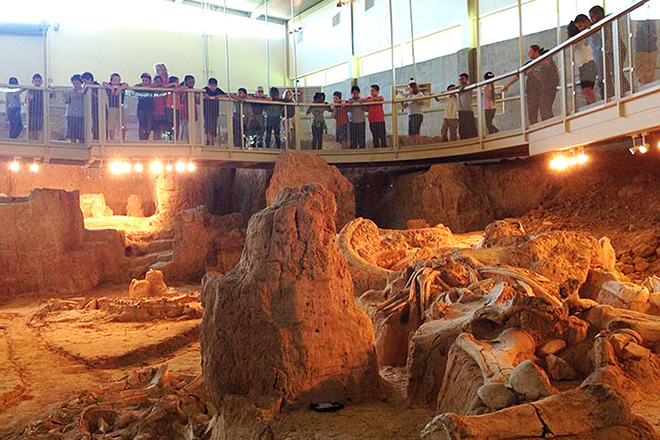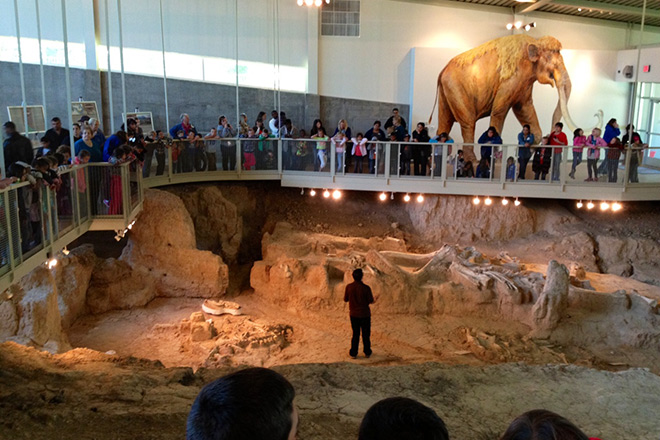NPCA interviews Waco Mammoth Program Coordinator Raegan King, who oversees Waco Mammoth National Monument and currently serves as president of the Museum Association of Waco.
Today, President Obama designated America’s newest national park site at Waco Mammoth, preserving a trove of exceptional Ice Age fossils in Waco, Texas. Unlike many other brand-new parks, Waco Mammoth National Monument is already an established educational facility and a jewel of the community. For years, researchers and schoolkids alike have been getting a glimpse into America’s wild past by learning from this scientifically significant collection of remains.
I spoke with Waco Mammoth Program Coordinator Raegan King who oversees the site and currently serves as president of the Museum Association of Waco to learn more about this fascinating new part of the park system.
Q: What do you do at Waco Mammoth?
A: I am essentially the site’s operations director. I hire and train staff, I monitor the finances, and I oversee how we deliver information to the public, whether it’s on site, via the media, or traveling to schools. Also, I help oversee the educational programming that we do.
“Many new parks aren’t open to the public yet. They don’t have infrastructure. They don’t have a maintenance budget. They don’t have an educational program. We have all that. It can only get better from here.”-Raegan King, Waco Mammoth program coordinator
Q: Can you tell me about the park?
A: Waco Mammoth National Monument is five acres of one of the richest Ice Age fossil beds in the world. What is unique about the Waco Mammoth National Monument is that we found the world’s only nursery herd of Columbian mammoths. “Nursery herd” means a group of females and their babies, a family unit.
Q: What is the significance of finding this kind of herd?
A: One of the goals of paleontology is to look at some object, preferably an animal fossil, and make educated predictions about how that animal lived and died. Because the nursery herd died together simultaneously, we know that they behaved much like elephants do today. It’s very unusual for fossil remains to tell you about the behavior of animals, but ours provide information that you can’t find anywhere else. That’s why this site is so important to science.
Q: Do you know how that herd died?
A: Our nursery herd seems to have been mired in a creek bed that was probably dry and muddy at the time, and they succumbed to rapidly rising water.
Q: So the mammoths drowned, and based on how they were clustered together in the creek, you can understand how they behaved?
A: That’s right. The majority of the remains were young adults and adult females with a few of their babies, and that is very typical of modern-day elephant herds. Females in modern-day herds are related. They are literally a family. It’s their biological drive to protect their babies, and that’s what we’re seeing with this grouping of mammoths. They had to be protecting their babies. They had to be sticking together, like the herd structure we see today.
Q: What other kinds of fossils have you found at the site?
A: The dig shelter protects about an acre that’s been excavated. It protects six of our 23 mammoths that we know exist at the site—so far. Inside the dig shelter, we have preserved remains of a few female mammoths and the only adult bull mammoth we have found at the site. We also have a single tooth from a saber-tooth cat, probably a juvenile or baby, and an American camel. A lot of people are not aware that camels got their start in North America. We also found the remains of one unidentified animal. We haven’t quite figured out what it is yet, because it’s just ribs. We have also found a giant tortoise, a dwarf antelope, a bison, and a few other items that we think are potentially antelope or deer.
The entire site [owned by the city of Waco] is 107 acres, but the monument is only five of those acres. The most significant part of the site is the monument.
Q: So there’s a chance that there are other fossils or artifacts that are part of the larger site that you don’t even know about yet?
A: Correct.
Q: How old are these animals?
A: Our oldest set of remains dates back between about 65,000 to 72,000 years ago. The oldest flooding event that we know of so far at our site happened approximately 65,000 years ago. That was the death of the nursery herd.
Q: Can you tell me about the museum?
A: We refer to the dig shelter as a museum because we interpret the remains just like a docent would interpret exhibits inside of a traditional museum. We also have added interpretive signs, and toward the end of the tour we have a display case and a small hands-on exhibit where kids can touch and see the true size of a mammoth femur leg bone. We have a replica cast of one of our main mammoth ribs that kids can touch as well.
Q: I understand you see a lot of schoolkids.
A: Oh, yes. We just had another 110 today.
Q: Do you also host researchers and scientists?
A: Because the Mayborn Museum is our repository at Baylor University, they help us manage the scientific research. They also hold our plaster jackets that hopefully, with increased research activity, will be studied more in-depth. Right now, we are working with Baylor University Geosciences on some soil sampling dating techniques and other micro-research of literally just the dirt.
Q: What are plaster jackets?
A: A plaster jacket is applied to a fossil in the field to stabilize it before it is put in storage at a museum.
Q: My understanding is that the city and the university have been working with the National Park Service for years on the preservation techniques at Waco Mammoth. Were you hoping for this Park Service designation all along?
A: Absolutely. Since our excavation team back in the 80s and 90s realized the importance of what they were finding—that this was unlike any other site in the world—every effort has been made to handle the remains and the development of the park per national park standards.
We have already been an operational park for over five years, and we already have been using the best standards in the world for care and preservation of our resources. It’s only a natural transition to become a unit of the National Park Service. I’ve been here two and a half years, and it’s always been a goal. To get the designation is absolutely a dream come true.
Our biggest advantage is that the entire collection is still in Waco. Every last bit. That’s quite unheard of when you’re talking about large fossil sites. They tend to get dispersed and sent to other research institutions. But everything has been kept in Waco, and that’s really phenomenal.
Q: Has the community been supportive?
A: The public of Waco is 110% in support of this. This is a major source of pride for the community, and they want to share it with the world. And of course, it can benefit the city through tourism.
Q: People get that connection?
A: They really, really do. People would ask constantly how the progress was going. They really are interested in the development of the site.
Q: Will the designation change your day-to-day work and how you run things?
A: Immediately, absolutely not. We will still function the way we have. Again, we’re lucky that we already functioned as a park before the designation. Many new parks aren’t open to the public yet. They don’t have infrastructure. They don’t have a maintenance budget. They don’t have an educational program. We have all that. It can only get better from here.
Q: How have you funded all of these programs without federal support?
A: The Waco Mammoth Foundation was formed before the park even opened to the public for the sole purpose of raising funds to preserve the amazing fossils here. They raised over $4 million to build the dig shelter, the parking lot, the welcome center, and all of the amenities we have for guests. The amount of money they raised in such a short time is a testament to the community support. People believe in the importance of these fossils and want to keep them preserved for future generations.
The Waco Mammoth National Monument is a unique partnership park. NPS isn’t taking over per se. They’re entering an already very functional and happy partnership, and we completely welcome them with open arms.
Q: What is your favorite part of working there?
A: It’s when a kid looks at you and says, “Wow! This is the coolest place ever.”
Of course, we as a staff think it’s the coolest place ever. We love science. We love teaching and learning more about the history that we share with this amazing place. If you can get a kid or even a grown-up to appreciate that—that’s why we do our jobs.
It’s been so much fun and very exciting to see a park so young develop so quickly. I’ve worked at museums, but they’re a hundred years old and already well-established. To be able to see this develop from its infancy is very, very exciting.
Q: What would you recommend for someone planning to visit Waco Mammoth for the first time?
A: You absolutely need to go on a guided tour of the dig shelter. Go down to the monument with one of our guides, and they will amaze you with how much information is hidden within all of these bones and fossils. We also have a really neat gift shop and a picnic area. Plan to spend an hour or two in the park and be amazed!
Learn more about the Waco Mammoth National Monument on the National Park Service website.
About the author
-
 Jennifer Errick Former Associate Director of Digital Storytelling
Jennifer Errick Former Associate Director of Digital StorytellingJennifer co-produced NPCA's podcast, The Secret Lives of Parks, and wrote and edited a wide variety of online content. She has won multiple awards for her audio storytelling.
-
General
-
Issues




